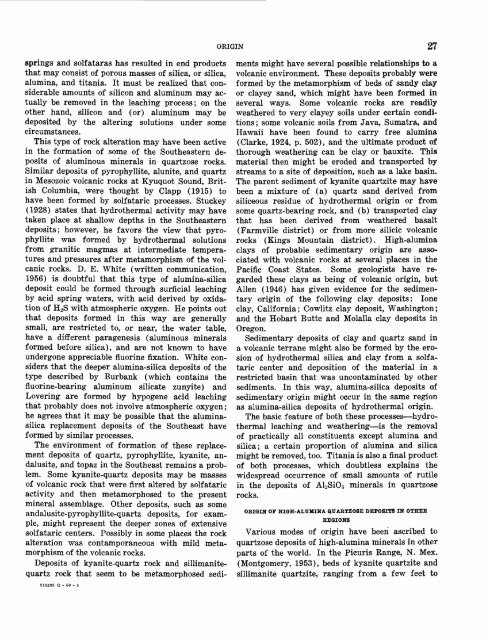Kyanite, Sillimanite, and Andalusite Deposits of the Southeastern ...
Kyanite, Sillimanite, and Andalusite Deposits of the Southeastern ...
Kyanite, Sillimanite, and Andalusite Deposits of the Southeastern ...
You also want an ePaper? Increase the reach of your titles
YUMPU automatically turns print PDFs into web optimized ePapers that Google loves.
ORIGIN 27<br />
510205 O - 60 - 3<br />
springs <strong>and</strong> solfataras has resulted in end products<br />
that may consist <strong>of</strong> porous masses <strong>of</strong> silica, or silica,<br />
alumina, <strong>and</strong> titania. It must be realized that considerable<br />
amounts <strong>of</strong> silicon <strong>and</strong> aluminum may actually<br />
be removed in <strong>the</strong> leaching process; on <strong>the</strong><br />
o<strong>the</strong>r h<strong>and</strong>, silicon <strong>and</strong> (or) aluminum may be<br />
deposited by <strong>the</strong> altering solutions under some<br />
circumstances.<br />
This type <strong>of</strong> rock alteration may have been active<br />
in <strong>the</strong> formation <strong>of</strong> some <strong>of</strong> <strong>the</strong> Sou<strong>the</strong>astern deposits<br />
<strong>of</strong> aluminous minerals in quartzose rocks.<br />
Similar deposits <strong>of</strong> pyrophyllite, alunite, <strong>and</strong> quartz<br />
in Mesozoic volcanic rocks at Kyuquot Sound, British<br />
Columbia, were thought by Clapp (1915) to<br />
have been formed by solfataric processes. Stuckey<br />
(1928) states that hydro<strong>the</strong>rmal activity may have<br />
taken place at shallow depths in <strong>the</strong> Sou<strong>the</strong>astern<br />
deposits; however, he favors <strong>the</strong> view that pyrophyllite<br />
was formed by hydro<strong>the</strong>rmal solutions<br />
from granitic magmas at intermediate temperatures<br />
<strong>and</strong> pressures after metamorphism <strong>of</strong> <strong>the</strong> volcanic<br />
rocks. D. E. White (written communication,<br />
1956) is doubtful that this type <strong>of</strong> alumina-silica<br />
deposit could be formed through surficial leaching<br />
by acid spring waters, with acid derived by oxidation<br />
<strong>of</strong> H 2S with atmospheric oxygen. He points out<br />
that deposits formed in this way are generally<br />
small, are restricted to, or near, <strong>the</strong> water table,<br />
have a different paragenesis (aluminous minerals<br />
formed before silica), <strong>and</strong> are not known to have<br />
undergone appreciable fluorine fixation. White considers<br />
that <strong>the</strong> deeper alumina-silica deposits <strong>of</strong> <strong>the</strong><br />
type described by Burbank (which contains <strong>the</strong><br />
fluorine-bearing aluminum silicate zunyite) <strong>and</strong><br />
Levering are formed by hypogene acid leaching<br />
that probably does not involve atmospheric oxygen;<br />
he agrees that it may be possible that <strong>the</strong> aluminasilica<br />
replacement deposits <strong>of</strong> <strong>the</strong> Sou<strong>the</strong>ast have<br />
formed by similar processes.<br />
The environment <strong>of</strong> formation <strong>of</strong> <strong>the</strong>se replacement<br />
deposits <strong>of</strong> quartz, pyrophyllite, kyanite, <strong>and</strong>alusite,<br />
<strong>and</strong> topaz in <strong>the</strong> Sou<strong>the</strong>ast remains a problem.<br />
Some kyanite-quartz deposits may be masses<br />
<strong>of</strong> volcanic rock that were first altered by solfataric<br />
activity <strong>and</strong> <strong>the</strong>n metamorphosed to <strong>the</strong> present<br />
mineral assemblage. O<strong>the</strong>r deposits, such as some<br />
<strong>and</strong>alusite-pyrophyllite-quartz deposits, for example,<br />
might represent <strong>the</strong> deeper zones <strong>of</strong> extensive<br />
solfataric centers. Possibly in some places <strong>the</strong> rock<br />
alteration was contamporaneous with mild metamorphism<br />
<strong>of</strong> <strong>the</strong> volcanic rocks.<br />
<strong>Deposits</strong> <strong>of</strong> kyanite-quartz rock <strong>and</strong> sillimanitequartz<br />
rock that seem to be metamorphosed sediments<br />
might have several possible relationships to a<br />
volcanic environment. These deposits probably were<br />
formed by <strong>the</strong> metamorphism <strong>of</strong> beds <strong>of</strong> s<strong>and</strong>y clay<br />
or clayey s<strong>and</strong>, which might have been formed in<br />
several ways. Some volcanic rocks are readily<br />
wea<strong>the</strong>red to very clayey soils under certain conditions;<br />
some volcanic soils from Java, Sumatra, <strong>and</strong><br />
Hawaii have been found to carry free alumina<br />
(Clarke, 1924, p. 502), <strong>and</strong> <strong>the</strong> ultimate product <strong>of</strong><br />
thorough wea<strong>the</strong>ring can be clay or bauxite. This<br />
material <strong>the</strong>n might be eroded <strong>and</strong> transported by<br />
streams to a site <strong>of</strong> deposition, such as a lake basin.<br />
The parent sediment <strong>of</strong> kyanite quartzite may have<br />
been a mixture <strong>of</strong> (a) quartz s<strong>and</strong> derived from<br />
siliceous residue <strong>of</strong> hydro<strong>the</strong>rmal origin or from<br />
some quartz-bearing rock, <strong>and</strong> (b) transported clay<br />
that has been derived from wea<strong>the</strong>red basalt<br />
(Farmville district) or from more silicic volcanic<br />
rocks (Kings Mountain district). High-alumina<br />
clays <strong>of</strong> probable sedimentary origin are associated<br />
with volcanic rocks at several places in <strong>the</strong><br />
Pacific Coast States. Some geologists have regarded<br />
<strong>the</strong>se clays as being <strong>of</strong> volcanic origin, but<br />
Alien (1946) has given evidence for <strong>the</strong> sedimentary<br />
origin <strong>of</strong> <strong>the</strong> following clay deposits: lone<br />
clay, California; Cowlitz clay deposit, Washington;<br />
<strong>and</strong> <strong>the</strong> Hobart Butte <strong>and</strong> Molalla clay deposits in<br />
Oregon.<br />
Sedimentary deposits <strong>of</strong> clay <strong>and</strong> quartz s<strong>and</strong> in<br />
a volcanic terrane might also be formed by <strong>the</strong> erosion<br />
<strong>of</strong> hydro<strong>the</strong>rmal silica <strong>and</strong> clay from a solfataric<br />
center <strong>and</strong> deposition <strong>of</strong> <strong>the</strong> material in a<br />
restricted basin that was uncontaminated by o<strong>the</strong>r<br />
sediments. In this way, alumina-silica deposits <strong>of</strong><br />
sedimentary origin might occur in <strong>the</strong> same region<br />
as alumina-silica deposits <strong>of</strong> hydro<strong>the</strong>rmal origin.<br />
The basic feature <strong>of</strong> both <strong>the</strong>se processes hydro<strong>the</strong>rmal<br />
leaching <strong>and</strong> wea<strong>the</strong>ring is <strong>the</strong> removal<br />
<strong>of</strong> practically all constituents except alumina <strong>and</strong><br />
silica; a certain proportion <strong>of</strong> alumina <strong>and</strong> silica<br />
might be removed, too. Titania is also a final product<br />
<strong>of</strong> both processes, which doubtless explains <strong>the</strong><br />
widespread occurrence <strong>of</strong> small amounts <strong>of</strong> rutile<br />
in <strong>the</strong> deposits <strong>of</strong> Al2Si0 5 minerals in quartzose<br />
rocks.<br />
ORIGIN OF HIGH-ALUMINA QUARTZOSE DEPOSITS IN OTHER<br />
REGIONS<br />
Various modes <strong>of</strong> origin have been ascribed to<br />
quartzose deposits <strong>of</strong> high-alumina minerals in o<strong>the</strong>r<br />
parts <strong>of</strong> <strong>the</strong> world. In <strong>the</strong> Picuris Range, N. Mex.<br />
(Montgomery, 1953), beds <strong>of</strong> kyanite quartzite <strong>and</strong><br />
sillimanite quartzite, ranging from a few feet to
















